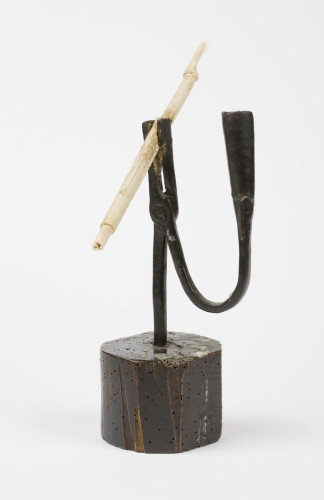M 420
Collection
Metalwork
Brief description
Iron rushlight and candle holder with a wooden base, made in Ireland, 1700-1800.
Object name
rushlight and candle holder
Object number
M 420
Location
On Display
Production date
1700-1800 (manufactured)
Production place
Ireland (manufactured)
Period
Stuart (1603-1714)
Georgian (1714-1837)
Georgian (1714-1837)
Material
iron
wood
wood
Technique
wrought
hammered
joined
hammered
joined
Physical description
Iron rushlight on an irregular wooden hexagonal base, consisting of a vertical rush holder with a long socket and horizontal nip bits, and a socket for a candle on a pronounced u-bend with a 'v' shape in its rim. The rushlight shows evidence of metal joining.
Dimensions
Height: 20.5cm
Width: 10cm
Depth: 8cm
Diameter: 7cm
Width: 10cm
Depth: 8cm
Diameter: 7cm
Website keywords
candle and rush lighting
Label
Label text for 'Lighting the home' case, Information Bay 5, Geffrye Museum, 2010:
Rush-light holder, or ‘rushnip’, eighteenth century
Iron and wood
Dried rushes dipped in melted fat supplied the cheapest form of lighting. The rush was held horizontally between the holder’s iron ‘pincers’, and one end was lit. It would burn for about twenty minutes, but could give additional light if both ends were lit. This practice gave rise to the expression ‘burning the candle at both ends’.
Rush-light holder, or ‘rushnip’, eighteenth century
Iron and wood
Dried rushes dipped in melted fat supplied the cheapest form of lighting. The rush was held horizontally between the holder’s iron ‘pincers’, and one end was lit. It would burn for about twenty minutes, but could give additional light if both ends were lit. This practice gave rise to the expression ‘burning the candle at both ends’.




